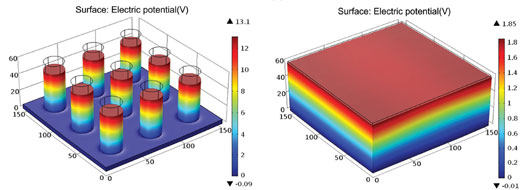| Posted: Jun 16, 2017 | |
Piezoelectric nanogenerators for self-powered flexible sensors(Nanowerk News) Researchers in China have demonstrated a high performance flexible piezoelectric nanogenerator (PENG) based on a piezoelectrically enhanced nanocomposite micropillar array of BaTiO3 nanoparticles embedded into a highly crystalline polymer for efficient energy harvesting and highly sensitive self-powered sensing. |
|
| The team reported their findings in Small ("High-Performance Piezoelectric Nanogenerators with Imprinted P(VDF-TrFE)/BaTiO3 Nanocomposite Micropillars for Self-Powered Flexible Sensors"). | |
| Mechanical energy with various types such as sound waves, mechanical impacts, flowing air, and human motions are most abundant energy in our living surrounding. In this framework, flexible sensors rely on piezoelectric potential generated in piezoelectric materials as a response to applied strain, have attracted extensive attentions. | |
| Their relatively small size factor, simple structure, and long-term stability make them favorable for use in powering micro/nanosystems, various small power consumer devices, remote and mobile sensors, and even wearable wireless electronics. | |
| In particular, the output from the flexible piezoelectric nanogenerators not just limited in energy-harvesting purpose, the ability of piezoelectric materials to generate different levels of electricity in response to various mechanical stimuli with high sensitivity and fast response time enabled the realization of self-powered piezoelectric e-skins with tactile sensing capabilities. | |
| In fact, it has recently been demonstrated as a sensor signal for detecting the mechanical deformation, for instance monitoring tire pressure. | |
| The Chinese team's PENG is based on piezoelectrically enhanced micropillars that were fabricated via a facile, reliable, and scalable nanoimprinting process to further improve their performance. | |
| The researchers point out that the vertically well-aligned structure of their nanocomposite micropillar array results in a macroscopic piezopotential that can produce a peak output voltage of 13.2 V and an average current density of 0.33 µA cm-2. This means the piezoelectric voltage was enhanced to 7.3 times that of the pristine flat polymer film under the same vertical compressive force. | |
 |
|
| Left represents the unit micropillar array with a diameter of 22 µm and a height of 55 µm, the residual layer is 5 µm. Right represents a flat film unit with a thickness of 60 µm. (© Wiley-VCH Verlag) | |
| The team reports that under repeated mechanical impact, stable electricity was generated from the nanogenerator and used to drive electronic devices (such as LCD screen, arrays of blue LEDs connected in series, digital watch, and music player) to work continuously. | |
| The piezoelectrically enhanced nanocomposite micropillar array in this work was also successfully demonstrated as highly sensitive self-powered sensor work in a noncontact mode for detecting air pressure/flow. It also can be used as wearable sensors for measuring human vital signals including breathing, heart beating. | |
| "Because of the distinctive features of high sensitivity, good stability, and high power-generating property, the proposed nanocomposite micropillar array based nanogenerator will have a wide potential application in fields of the smart clothes, medical sciences, and next-generation electronics," the authors conclude. |
 By
Michael
Berger
– Michael is author of three books by the Royal Society of Chemistry:
Nano-Society: Pushing the Boundaries of Technology,
Nanotechnology: The Future is Tiny, and
Nanoengineering: The Skills and Tools Making Technology Invisible
Copyright ©
Nanowerk LLC
By
Michael
Berger
– Michael is author of three books by the Royal Society of Chemistry:
Nano-Society: Pushing the Boundaries of Technology,
Nanotechnology: The Future is Tiny, and
Nanoengineering: The Skills and Tools Making Technology Invisible
Copyright ©
Nanowerk LLC
|
|
|
Subscribe to a free copy of one of our daily Nanowerk Newsletter Email Digests with a compilation of all of the day's news. |
